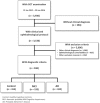Usefulness of peripapillary nerve fiber layer thickness assessed by optical coherence tomography as a biomarker for Alzheimer's disease
- PMID: 30397251
- PMCID: PMC6218495
- DOI: 10.1038/s41598-018-34577-3
Usefulness of peripapillary nerve fiber layer thickness assessed by optical coherence tomography as a biomarker for Alzheimer's disease
Erratum in
-
Author Correction: Usefulness of peripapillary nerve fiber layer thickness assessed by optical coherence tomography as a biomarker for Alzheimer's disease.Sci Rep. 2019 Nov 8;9(1):16713. doi: 10.1038/s41598-019-53339-3. Sci Rep. 2019. PMID: 31700096 Free PMC article.
Abstract
The use of optical coherence tomography (OCT) has been suggested as a potential biomarker for Alzheimer's Disease based on previously reported thinning of the retinal nerve fiber layer (RNFL) in Alzheimer's disease's (AD) and Mild Cognitive Impairment (MCI). However, other studies have not shown such results. 930 individuals (414 cognitively healthy individuals, 192 probable amnestic MCI and 324 probable AD) attending a memory clinic were consecutively included and underwent spectral domain OCT (Maestro, Topcon) examinations to assess differences in peripapillary RNFL thickness, using a design of high ecological validity. Adjustment by age, education, sex and OCT image quality was performed. We found a non-significant decrease in mean RNFL thickness as follows: control group: 100,20 ± 14,60 µm, MCI group: 98,54 ± 14,43 µm and AD group: 96,61 ± 15,27 µm. The multivariate adjusted analysis revealed no significant differences in mean overall (p = 0.352), temporal (p = 0,119), nasal (p = 0,151), superior (p = 0,435) or inferior (p = 0,825) quadrants between AD, MCI and control groups. These results do not support the usefulness of peripapillary RNFL analysis as a marker of cognitive impairment or in discriminating between cognitive groups. The analysis of other OCT measurements in other retinal areas and layers as biomarkers for AD should be tested further.
Conflict of interest statement
A.P. is currently an employee of Topcon Spain. All the other authors have no conflict of interests to report.
Figures



Similar articles
-
Evaluation of macular thickness and volume tested by optical coherence tomography as biomarkers for Alzheimer's disease in a memory clinic.Sci Rep. 2020 Jan 31;10(1):1580. doi: 10.1038/s41598-020-58399-4. Sci Rep. 2020. PMID: 32005868 Free PMC article.
-
Analysis of the Retinal Nerve Fiber Layer Thickness in Alzheimer Disease and Mild Cognitive Impairment.Korean J Ophthalmol. 2017 Dec;31(6):548-556. doi: 10.3341/kjo.2016.0118. Epub 2017 Nov 27. Korean J Ophthalmol. 2017. PMID: 29022297 Free PMC article.
-
Visualization of Focal Thinning of the Ganglion Cell-Inner Plexiform Layer in Patients with Mild Cognitive Impairment and Alzheimer's Disease.J Alzheimers Dis. 2018;64(4):1261-1273. doi: 10.3233/JAD-180070. J Alzheimers Dis. 2018. PMID: 30040712
-
Spectral-Domain OCT Measurements in Alzheimer's Disease: A Systematic Review and Meta-analysis.Ophthalmology. 2019 Apr;126(4):497-510. doi: 10.1016/j.ophtha.2018.08.009. Epub 2018 Aug 13. Ophthalmology. 2019. PMID: 30114417 Free PMC article.
-
Optical coherence tomography in mild cognitive impairment - Systematic review and meta-analysis.Clin Neurol Neurosurg. 2020 Sep;196:106036. doi: 10.1016/j.clineuro.2020.106036. Epub 2020 Jun 22. Clin Neurol Neurosurg. 2020. PMID: 32623211
Cited by
-
Identification of Retinal Biomarkers in Alzheimer's Disease Using Optical Coherence Tomography: Recent Insights, Challenges, and Opportunities.J Clin Med. 2019 Jul 9;8(7):996. doi: 10.3390/jcm8070996. J Clin Med. 2019. PMID: 31323964 Free PMC article. Review.
-
Association of Cognitive Function with Amyloid-β and Tau Proteins in the Vitreous Humor.J Alzheimers Dis. 2019;68(4):1429-1438. doi: 10.3233/JAD-181104. J Alzheimers Dis. 2019. PMID: 30856114 Free PMC article.
-
Thinner inner retinal layers are associated with lower cognitive performance, lower brain volume, and altered white matter network structure-The Maastricht Study.Alzheimers Dement. 2024 Jan;20(1):316-329. doi: 10.1002/alz.13442. Epub 2023 Aug 23. Alzheimers Dement. 2024. PMID: 37611119 Free PMC article.
-
Retinal microvasculature dysfunction is associated with Alzheimer's disease and mild cognitive impairment.Alzheimers Res Ther. 2020 Dec 4;12(1):161. doi: 10.1186/s13195-020-00724-0. Alzheimers Res Ther. 2020. PMID: 33276820 Free PMC article.
-
Interplay Between Macular Retinal Changes and White Matter Integrity in Early Alzheimer's Disease.J Alzheimers Dis. 2019;70(3):723-732. doi: 10.3233/JAD-190152. J Alzheimers Dis. 2019. PMID: 31282416 Free PMC article.
References
-
- Morris JC, et al. Mild Cognitive Impairment Represents Early-Stage Alzheimer Disease. Arch. Neurol. 2001;58:124–129. - PubMed
Publication types
MeSH terms
Substances
LinkOut - more resources
Full Text Sources
Medical

